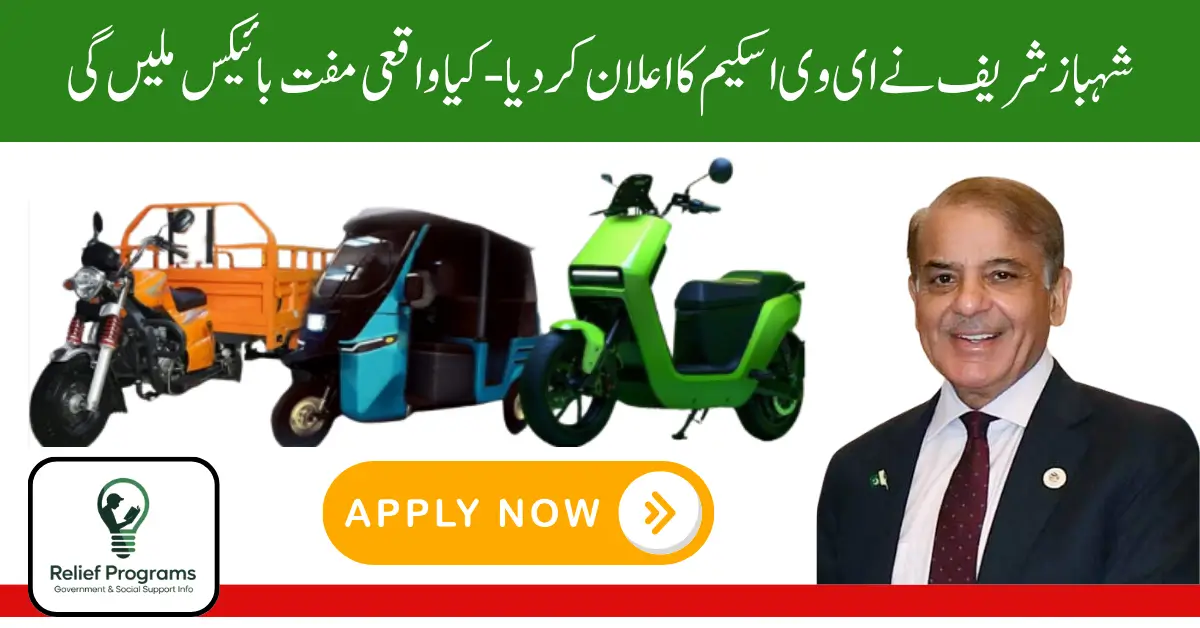The EV Scheme 2025 announced by Prime Minister Shehbaz Sharif aims to revolutionize transportation in Pakistan by promoting electric mobility, especially through subsidized electric bikes. With climate change accelerating and fuel prices soaring, Pakistan finds itself at a turning point. While the announcement has sparked public interest, the central question remains: are electric bikes really being offered for free? The truth is layered.

While some individuals may indeed receive electric bikes without paying upfront, the broader approach involves government-backed subsidies. The aim is to make electric mobility more accessible, especially for students, workers, and low-income families.
For More Information: Breaking News! Aghosh Program Payment Increased to Rs. 38,000
The Purpose Behind the Announcement
This initiative isn’t just about promoting cleaner transportation. It’s a strategic effort to reduce national fuel dependence and provide cost-effective mobility solutions to those who need it most. By shifting focus toward sustainable vehicles, the government hopes to modernize the transport sector and cut emissions without burdening everyday citizens.
Program Overview
| Topic | Key Information |
| Scheme Name | EV Scheme 2025 |
| Announced By | Prime Minister Shehbaz Sharif |
| Primary Goal | Promote affordable electric mobility, reduce emissions |
| Are Bikes Truly Free? | Only for eligible applicants; mostly high subsidies, not universal free access |
| Who Qualifies? | Students, workers, women, and individuals with disabilities |
| Funding Source | National development funds, local manufacturing incentives |
| Application Process | Likely through an online portal; documents and verification required |
| Major Challenges | Infrastructure gaps, production delays, administrative bottlenecks |
| Expected Long-Term Benefits | Cleaner cities, job creation, reduced dependence on imported fuel |
What’s Really Meant by “Free” Electric Bikes?
The phrase “free electric bikes” quickly grabbed headlines, but as always, the details matter. The government is not promising no-cost bikes to all citizens. Instead, it is offering substantial financial support for certain groups through subsidies and installment plans. For eligible applicants, this support could mean a bike at little to no personal cost.
However, “free” doesn’t always mean completely free. There may still be some minor registration or setup charges that recipients will need to cover.
For More Information: How to Track BISP 13500 Payment Without Internet
Who Can Apply for the Electric Bike Program?
The plan prioritizes groups who depend heavily on personal transport for education or employment but can’t afford high fuel or vehicle costs. These include:
- Students at government-recognized universities or vocational institutes
- Low-wage workers in the private or public sector
- Women needing reliable personal transport
- Persons with physical disabilities or special mobility needs
These categories are not exhaustive, but they represent the primary target audiences for early phases of the scheme.
Financing the Initiative
The government plans to fund this initiative through a combination of national development funds and incentives for local manufacturers. By encouraging local assembly of electric bikes, the cost of production is expected to fall, making the subsidies more sustainable. In addition, tax exemptions on components and favorable loan terms may be offered to partnering manufacturers.
The success of the program will largely depend on whether the financial support is enough to meet growing public demand.
For More Information: BISP 8171 Online Check Balance A Step-by-Step Guide
Potential Barriers to Success
Despite the promise of progress, the program faces practical hurdles. Infrastructure for electric vehicles in Pakistan is still developing. Many cities lack charging stations, and public awareness around electric transport is low.
Some of the key challenges include:
- Limited manufacturing capacity: Domestic producers may struggle to meet a sudden rise in demand.
- Lack of charging infrastructure: Without accessible charging points, users may hesitate to make the switch.
- Administrative red tape: The process of applying, verifying documents, and receiving a bike could get bogged down in delays.
Comparing with Previous Efforts
Pakistan has attempted similar transitions before, such as the promotion of CNG rickshaws and solar-powered systems. These efforts had mixed results, often due to inconsistent policy enforcement or lack of public engagement. What makes this announcement different is its timing — the global shift toward electric vehicles is now stronger than ever, and public interest is high.
If the government ensures continuity, this could be one of Pakistan’s most impactful transport reforms in recent years.
For More Information: Ehsaas Program October 2025 Payments
How the Public Can Apply
Once the program launches officially, eligible individuals will likely be able to apply online through a government portal. The process may involve:
- Creating an account with verified CNIC details
- Uploading proof of income, address, and other documents
- Selecting from an approved list of electric bike models
Applicants may be contacted for interviews or further verification before the final approval is granted.
Long-Term Impact on the Transport Sector
Beyond the immediate benefits, this initiative could shift how urban Pakistan moves. Cleaner air, quieter streets, and lower commuting costs are only part of the potential. Local businesses producing parts and batteries could also thrive, creating new job opportunities. If successfully managed, this step could mark the beginning of a major economic and environmental transition for the country.
Conclusion
While the buzz around “free bikes” has sparked public excitement, the core message of the EV Scheme 2025 is about affordability, accessibility, and environmental responsibility. For many citizens, especially those who rely on daily transport for work or education, the scheme could be a practical game-changer. But success will hinge on execution — from infrastructure to fair distribution. As details unfold, all eyes are on how the government transforms this ambitious plan into a tangible, lasting reality.
